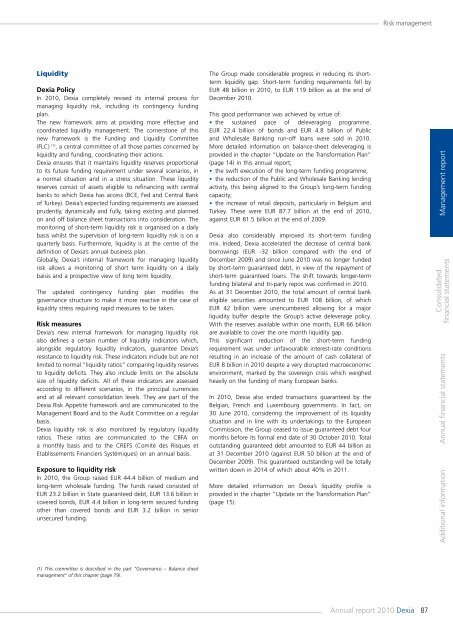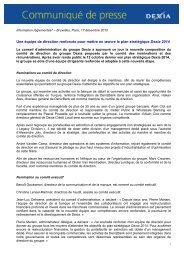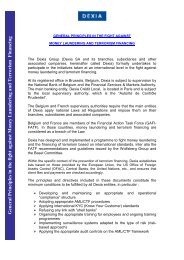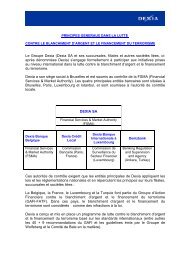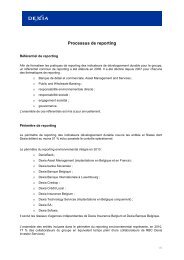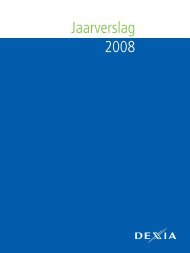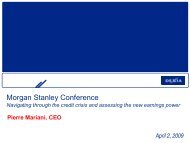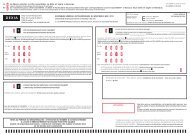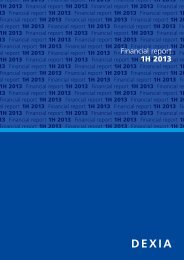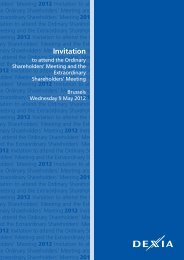Annual report 2010 - Dexia.com
Annual report 2010 - Dexia.com
Annual report 2010 - Dexia.com
- No tags were found...
Create successful ePaper yourself
Turn your PDF publications into a flip-book with our unique Google optimized e-Paper software.
Risk managementLiquidity<strong>Dexia</strong> PolicyIn <strong>2010</strong>, <strong>Dexia</strong> <strong>com</strong>pletely revised its internal process formanaging liquidity risk, including its contingency fundingplan.The new framework aims at providing more effective andcoordinated liquidity management. The cornerstone of thisnew framework is the Funding and Liquidity Committee(FLC) (1) , a central <strong>com</strong>mittee of all those parties concerned byliquidity and funding, coordinating their actions.<strong>Dexia</strong> ensures that it maintains liquidity reserves proportionalto its future funding requirement under several scenarios, ina normal situation and in a stress situation. These liquidityreserves consist of assets eligible to refinancing with centralbanks to which <strong>Dexia</strong> has access (BCE, Fed and Central Bankof Turkey). <strong>Dexia</strong>’s expected funding requirements are assessedprudently, dynamically and fully, taking existing and plannedon and off balance sheet transactions into consideration. Themonitoring of short-term liquidity risk is organised on a dailybasis whilst the supervision of long-term liquidity risk is on aquarterly basis. Furthermore, liquidity is at the centre of thedefinition of <strong>Dexia</strong>’s annual business plan.Globally, <strong>Dexia</strong>’s internal framework for managing liquidityrisk allows a monitoring of short term liquidity on a dailybaisis and a prospective view of long term liquidity.The updated contingency funding plan modifies thegovernance structure to make it more reactive in the case ofliquidity stress requiring rapid measures to be taken.Risk measures<strong>Dexia</strong>’s new internal framework for managing liquidity riskalso defines a certain number of liquidity indicators which,alongside regulatory liquidity indicators, guarantee <strong>Dexia</strong>’sresistance to liquidity risk. These indicators include but are notlimited to normal “liquidity ratios” <strong>com</strong>paring liquidity reservesto liquidity deficits. They also include limits on the absolutesize of liquidity deficits. All of these indicators are assessedaccording to different scenarios, in the principal currenciesand at all relevant consolidation levels. They are part of the<strong>Dexia</strong> Risk Appetite framework and are <strong>com</strong>municated to theManagement Board and to the Audit Committee on a regularbasis.<strong>Dexia</strong> liquidity risk is also monitored by regulatory liquidityratios. These ratios are <strong>com</strong>municated to the CBFA ona monthly basis and to the CREFS (Comité des Risques etEtablissements Financiers Systémiques) on an annual basis.Exposure to liquidity riskIn <strong>2010</strong>, the Group raised EUR 44.4 billion of medium andlong-term wholesale funding. The funds raised consisted ofEUR 23.2 billion in State guaranteed debt, EUR 13.6 billion incovered bonds, EUR 4.4 billion in long-term secured fundingother than covered bonds and EUR 3.2 billion in seniorunsecured funding.The Group made considerable progress in reducing its shorttermliquidity gap. Short-term funding requirements fell byEUR 48 billion in <strong>2010</strong>, to EUR 119 billion as at the end ofDecember <strong>2010</strong>.This good performance was achieved by virtue of:• the sustained pace of deleveraging programme.EUR 22.4 billion of bonds and EUR 4.8 billion of Publicand Wholesale Banking run-off loans were sold in <strong>2010</strong>.More detailed information on balance-sheet deleveraging isprovided in the chapter “Update on the Transformation Plan”(page 14) in this annual <strong>report</strong>;• the swift execution of the long-term funding programme;• the reduction of the Public and Wholesale Banking lendingactivity, this being aligned to the Group’s long-term fundingcapacity;• the increase of retail deposits, particularly in Belgium andTurkey. These were EUR 87.7 billion at the end of <strong>2010</strong>,against EUR 81.5 billion at the end of 2009.<strong>Dexia</strong> also considerably improved its short-term fundingmix. Indeed, <strong>Dexia</strong> accelerated the decrease of central bankborrowings (EUR -32 billion <strong>com</strong>pared with the end ofDecember 2009) and since June <strong>2010</strong> was no longer fundedby short-term guaranteed debt, in view of the repayment ofshort-term guaranteed loans. The shift towards longer-termfunding bilateral and tri-party repos was confirmed in <strong>2010</strong>.As at 31 December <strong>2010</strong>, the total amount of central bankeligible securities amounted to EUR 108 billion, of whichEUR 42 billion were unencumbered allowing for a majorliquidity buffer despite the Group’s active deleverage policy.With the reserves available within one month, EUR 66 billionare available to cover the one month liquidity gap.This significant reduction of the short-term fundingrequirement was under unfavourable interest-rate conditionsresulting in an increase of the amount of cash collateral ofEUR 8 billion in <strong>2010</strong> despite a very disrupted macroeconomicenvironment, marked by the sovereign crisis which weighedheavily on the funding of many European banks.In <strong>2010</strong>, <strong>Dexia</strong> also ended transactions guaranteed by theBelgian, French and Luxembourg governments. In fact, on30 June <strong>2010</strong>, considering the improvement of its liquiditysituation and in line with its undertakings to the EuropeanCommission, the Group ceased to issue guaranteed debt fourmonths before its formal end date of 30 October <strong>2010</strong>. Totaloutstanding guaranteed debt amounted to EUR 44 billion asat 31 December <strong>2010</strong> (against EUR 50 billion at the end ofDecember 2009). This guaranteed outstanding will be totallywritten down in 2014 of which about 40% in 2011.More detailed information on <strong>Dexia</strong>’s liquidity profile isprovided in the chapter “Update on the Transformation Plan”(page 15).Management <strong>report</strong>Consolidatedfinancial statementsAdditional information <strong>Annual</strong> financial statements(1) This <strong>com</strong>mittee is described in the part “Governance – Balance sheetmanagement” of this chapter (page 79).<strong>Annual</strong> <strong>report</strong> <strong>2010</strong> <strong>Dexia</strong>87


